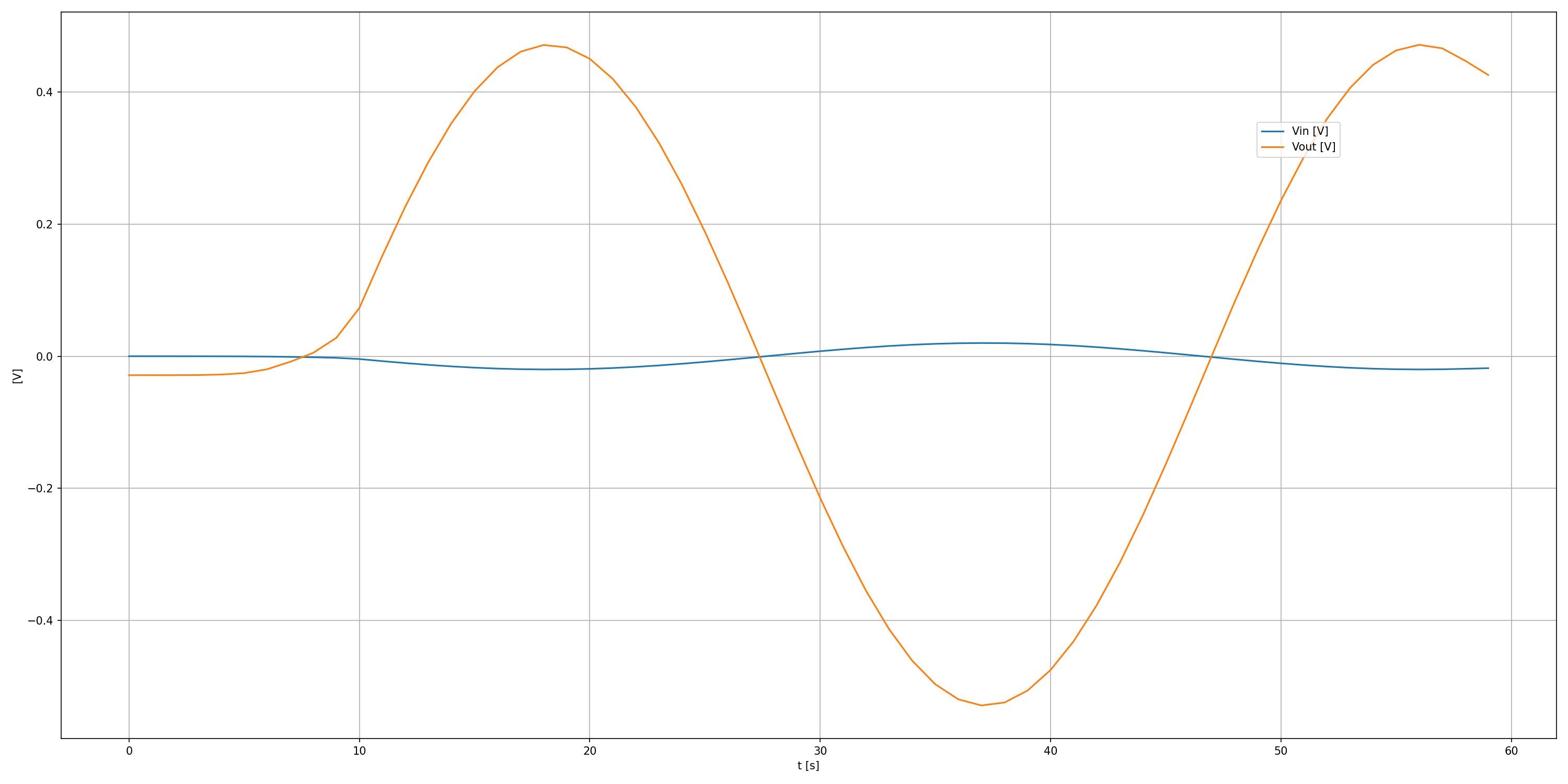#r#
#r# ==============================
#r# Kicad Netlist Parser Example
#r# ==============================
#r#
#r# This example shows how to read a netlist generated from the |Kicad|_ Schematic Editor.
#r#
#r# This example is copied from Stafford Horne's Blog:
#r# * http://stffrdhrn.github.io/electronics/2015/04/28/simulating_kicad_schematics_in_spice.html
#r# * https://github.com/stffrdhrn/kicad-spice-demo
#r#
#r# .. note:: The netlist must be generated using numbered node. Subcircuit elements must have a
#r# reference starting by *X* and a value corresponding to the subcircuit's name.
#r#
#f# image('kicad-pyspice-example/kicad-pyspice-example.sch.svg')
#r# The netlist generated by Kicad is the following:
#f# getthecode('kicad-pyspice-example/kicad-pyspice-example.cir')
####################################################################################################
from pathlib import Path
import matplotlib.pyplot as plt
####################################################################################################
import PySpice.Logging.Logging as Logging
logger = Logging.setup_logging()
####################################################################################################
from PySpice.Doc.ExampleTools import find_libraries
from PySpice.Probe.Plot import plot
from PySpice.Spice.Library import SpiceLibrary
from PySpice.Spice.Netlist import SubCircuitFactory
from PySpice.Spice.Parser import SpiceParser
from PySpice.Unit import *
####################################################################################################
libraries_path = find_libraries()
spice_library = SpiceLibrary(libraries_path)
####################################################################################################
#r# We implement the *PowerIn*, *Opamp*, *JackIn* and *JackOut* elements as subcircuit.
class PowerIn(SubCircuitFactory):
__name__ = 'PowerIn'
__nodes__ = ('output_plus', 'ground', 'output_minus')
##############################################
def __init__(self):
super().__init__()
self.V('positive', 'output_plus', 'ground', 3.3@u_V)
self.V('negative', 'ground', 'output_minus', 3.3@u_V)
####################################################################################################
class Opamp(SubCircuitFactory):
__name__ = 'Opamp'
__nodes__ = ('output',
'input_negative', 'input_positive',
'power_positive', 'power_negative')
##############################################
def __init__(self):
super().__init__()
self.X('opamp', 'LMV981',
'input_positive', 'input_negative',
'power_positive', 'power_negative',
'output',
'NSD')
####################################################################################################
class JackIn(SubCircuitFactory):
__name__ = 'JackIn'
__nodes__ = ('input', 'x', 'ground')
##############################################
def __init__(self):
super().__init__()
# could use SinusoidalVoltageSource as well
self.V('micro', 'ground', 'input', 'DC 0V AC 1V SIN(0 0.02 440)')
####################################################################################################
class JackOut(SubCircuitFactory):
__name__ = 'JackOut'
__nodes__ = ('output', 'x', 'ground')
##############################################
def __init__(self):
super().__init__()
self.R('load', 'output', 'x', 10@u_Ω)
####################################################################################################
#r# We read the generated netlist.
directory_path = Path(__file__).resolve().parent
kicad_netlist_path = directory_path.joinpath('kicad-pyspice-example', 'kicad-pyspice-example.cir')
parser = SpiceParser(path=str(kicad_netlist_path))
#r# We build the circuit and translate the ground (5 to 0).
circuit = parser.build_circuit(ground=5)
#r# We include the operational amplifier module.
circuit.include(spice_library['LMV981'])
#r# We define the subcircuits.
for subcircuit in (PowerIn(), Opamp(), JackIn(), JackOut()):
circuit.subcircuit(subcircuit)
# print(str(circuit))
#r# We perform a transient simulation.
simulator = circuit.simulator(temperature=25, nominal_temperature=25)
analysis = simulator.transient(step_time=100@u_us, end_time=3@u_ms)
figure, ax = plt.subplots(figsize=(20, 10))
ax.plot(analysis['2']) # JackIn input
ax.plot(analysis['7']) # Opamp output
ax.legend(('Vin [V]', 'Vout [V]'), loc=(.8,.8))
ax.grid()
ax.set_xlabel('t [s]')
ax.set_ylabel('[V]')
plt.tight_layout()
plt.show()
#f# save_figure('figure', 'kicad-example.png')
8.17. Kicad Netlist Parser Example¶
This example shows how to read a netlist generated from the Kicad Schematic Editor.
- This example is copied from Stafford Horne’s Blog:
Note
The netlist must be generated using numbered node. Subcircuit elements must have a reference starting by X and a value corresponding to the subcircuit’s name.
The netlist generated by Kicad is the following:
* /home/gv/fabrice/developpement/PySpice/examples/spice-parser/kicad-pyspice-example/kicad-pyspice-example.cir
* EESchema Netlist Version 1.1 (Spice format) creation date: dim. 29 nov. 2015 18:04:33 CET
* To exclude a component from the Spice Netlist add [Spice_Netlist_Enabled] user FIELD set to: N
* To reorder the component spice node sequence add [Spice_Node_Sequence] user FIELD and define sequence: 2,1,0
* Sheet Name: /
X3 7 6 5 4 1 Opamp
X1 2 5 5 JackIn
X4 7 3 5 JackOut
R2 6 7 50K
R1 2 6 2K
R3 5 3 2K
X2 4 5 1 PowerIn
.end
from pathlib import Path
import matplotlib.pyplot as plt
import PySpice.Logging.Logging as Logging
logger = Logging.setup_logging()
from PySpice.Doc.ExampleTools import find_libraries
from PySpice.Probe.Plot import plot
from PySpice.Spice.Library import SpiceLibrary
from PySpice.Spice.Netlist import SubCircuitFactory
from PySpice.Spice.Parser import SpiceParser
from PySpice.Unit import *
libraries_path = find_libraries()
spice_library = SpiceLibrary(libraries_path)
We implement the PowerIn, Opamp, JackIn and JackOut elements as subcircuit.
class PowerIn(SubCircuitFactory):
__name__ = 'PowerIn'
__nodes__ = ('output_plus', 'ground', 'output_minus')
def __init__(self):
super().__init__()
self.V('positive', 'output_plus', 'ground', 3.3@u_V)
self.V('negative', 'ground', 'output_minus', 3.3@u_V)
class Opamp(SubCircuitFactory):
__name__ = 'Opamp'
__nodes__ = ('output',
'input_negative', 'input_positive',
'power_positive', 'power_negative')
def __init__(self):
super().__init__()
self.X('opamp', 'LMV981',
'input_positive', 'input_negative',
'power_positive', 'power_negative',
'output',
'NSD')
class JackIn(SubCircuitFactory):
__name__ = 'JackIn'
__nodes__ = ('input', 'x', 'ground')
def __init__(self):
super().__init__()
# could use SinusoidalVoltageSource as well
self.V('micro', 'ground', 'input', 'DC 0V AC 1V SIN(0 0.02 440)')
class JackOut(SubCircuitFactory):
__name__ = 'JackOut'
__nodes__ = ('output', 'x', 'ground')
def __init__(self):
super().__init__()
self.R('load', 'output', 'x', 10@u_Ω)
We read the generated netlist.
directory_path = Path(__file__).resolve().parent
kicad_netlist_path = directory_path.joinpath('kicad-pyspice-example', 'kicad-pyspice-example.cir')
parser = SpiceParser(path=str(kicad_netlist_path))
We build the circuit and translate the ground (5 to 0).
circuit = parser.build_circuit(ground=5)
We include the operational amplifier module.
circuit.include(spice_library['LMV981'])
We define the subcircuits.
for subcircuit in (PowerIn(), Opamp(), JackIn(), JackOut()):
circuit.subcircuit(subcircuit)
# print(str(circuit))
We perform a transient simulation.
simulator = circuit.simulator(temperature=25, nominal_temperature=25)
analysis = simulator.transient(step_time=100@u_us, end_time=3@u_ms)
figure, ax = plt.subplots(figsize=(20, 10))
ax.plot(analysis['2']) # JackIn input
ax.plot(analysis['7']) # Opamp output
ax.legend(('Vin [V]', 'Vout [V]'), loc=(.8,.8))
ax.grid()
ax.set_xlabel('t [s]')
ax.set_ylabel('[V]')
plt.tight_layout()
plt.show()
